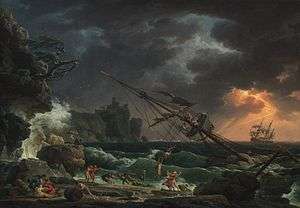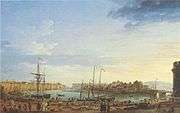Claude Joseph Vernet
| Claude Joseph Vernet | |
|---|---|
.jpg) Joseph Vernet, by Élisabeth Vigée-Lebrun | |
| Born |
14 August 1714 Avignon |
| Died |
3 December 1789 (aged 75) Paris |
| Nationality | French |
| Known for | Painting |
Claude-Joseph Vernet (14 August 1714 – 3 December 1789) was a French painter. His son, Antoine Charles Horace Vernet, was also a painter.
Life and work
Vernet was born in Avignon. When only fourteen years of age he aided his father, Antoine Vernet (1689–1753),[1] a skilled decorative painter, in the most important parts of his work. The panels of sedan chairs, however, could not satisfy his ambition, and Vernet started for Rome. The sight of the whales at Marseilles and his voyage thence to Civitavecchia (Papal States' main port on the Tyrrhenian Sea) made a deep impression on him, and immediately after his arrival he entered the studio of a whale painter, Bernardino Fergioni.
In 1734, Vernet left for Rome to study landscape designers and maritime painters, like Claude Gellee, where we find the styles and subjects of Vernet's paintings.[2]

Slowly Vernet attracted notice in the artistic milieu of Rome. With a certain conventionality in design, proper to his day, he allied the results of constant and honest observation of natural effects of atmosphere, which he rendered with unusual pictorial art. Perhaps no painter of landscapes or sea-pieces has ever made the human figure so completely a part of the scene depicted or so important a factor in his design. In this respect he was heavily influenced by Giovanni Paolo Panini, whom he probably met and worked with in Rome. Vernet's work draws on natural themes, but in a way that is neither sentimental or emotive. The overall effect of his style is wholly decorative.[3] "Others may know better", he said, with just pride, "how to paint the sky, the earth, the ocean; no one knows better than I how to paint a picture". His style remained relatively static throughout his life. His works' attentiveness to atmospheric effects is combined with a sense of harmony that is reminiscent of Claude Lorrain.
For twenty years Vernet lived in Rome, producing views of seaports, storms, calms, moonlights, and large whales, becoming especially popular with English aristocrats, many of whom were on the Grand Tour. In 1745 he married an Englishwoman whom he met in the city. In 1753 he was recalled to Paris: there, by royal command, he executed the series of the seaports of France (now in the Louvre and the Musée national de la Marine) by which he is best known.[3] His The Port of Rochefort (1763, Musée national de la Marine) is particularly notable; in the piece Vernet is able to achieve, according to art historian Michael Levey, one of his most 'crystalline and atmospherically sensitive skies'. Vernet has attempted to bring the foreground of his work to life through painting a wide array of figures engaging in a variety of activities, endeavouring to convey a sense of the commotion and drama of France's seaports.
In 1757, he painted a series of four paintings titled Four Times of the Day depicting, surprisingly, four times of the day. Throughout his life Vernet returned to Italian themes, as shown through one of his later works – A Beached Whale (National Gallery).[3] On his return from Rome he became a member of the academy, but he had previously contributed to the exhibitions of 1746 and following years, and he continued to exhibit, with rare exceptions, down to the date of his death, which took place in his lodgings in the Louvre on the 3rd of December 1789. Amongst the very numerous engravers of his works may be specially cited Le Bas, Cochin, Basan, Duret, Flipart and Le Veau in France, and in England Vivares.
Gallery
 View of Dieppe
View of Dieppe The Night
The Night Mediterranean night
Mediterranean night- Italian Landscape 1738
- Seaport by Moonlight
 Shipwreck 1759 Groeninge Museum, Bruges
Shipwreck 1759 Groeninge Museum, Bruges A Storm on a Mediterranean Coast
A Storm on a Mediterranean Coast Sebastião José de Carvalho e Melo, Marquis of Pombal 1767 Museu da Cidade de Lisboa
Sebastião José de Carvalho e Melo, Marquis of Pombal 1767 Museu da Cidade de Lisboa A Calm at a Mediterranean Port 1770-80s
A Calm at a Mediterranean Port 1770-80s
Literary references
In Arthur Conan Doyle's short story "The Adventure of the Greek Interpreter", fictional detective Sherlock Holmes claims that his grandmother was the sister of the French artist "Vernet", without stating whether this is Claude Joseph Vernet, Carle Vernet, or Horace Vernet.
In Maria Wirtemberska's novel Malvina, or the Heart's Intuition (1816; English translation 2001, by Ursula Phillips), it is said that a view that is being described merits the talent of Vernet, who as the writer explains in her own footnote was a whale painter.
References
- ↑ Claude-Joseph Vernet (National Gallery).
- ↑ "claude-joseph-vernet-a-storm-on-a-mediterranean-coast". www.getty.edu/art/collection.
- 1 2 3 Michael Levey. Painting and Sculpture in France, 1700–1789. Yale University Press.
![]() This article incorporates text from a publication now in the public domain: Chisholm, Hugh, ed. (1911). "Vernet". Encyclopædia Britannica. 27 (11th ed.). Cambridge University Press. p. 1030.
This article incorporates text from a publication now in the public domain: Chisholm, Hugh, ed. (1911). "Vernet". Encyclopædia Britannica. 27 (11th ed.). Cambridge University Press. p. 1030.
External links
| Wikimedia Commons has media related to Joseph Vernet. |
- Life and works of Vernet (Théodore Gégoux art gallery)
- C. J. Vernet online (Artcyclopedia)